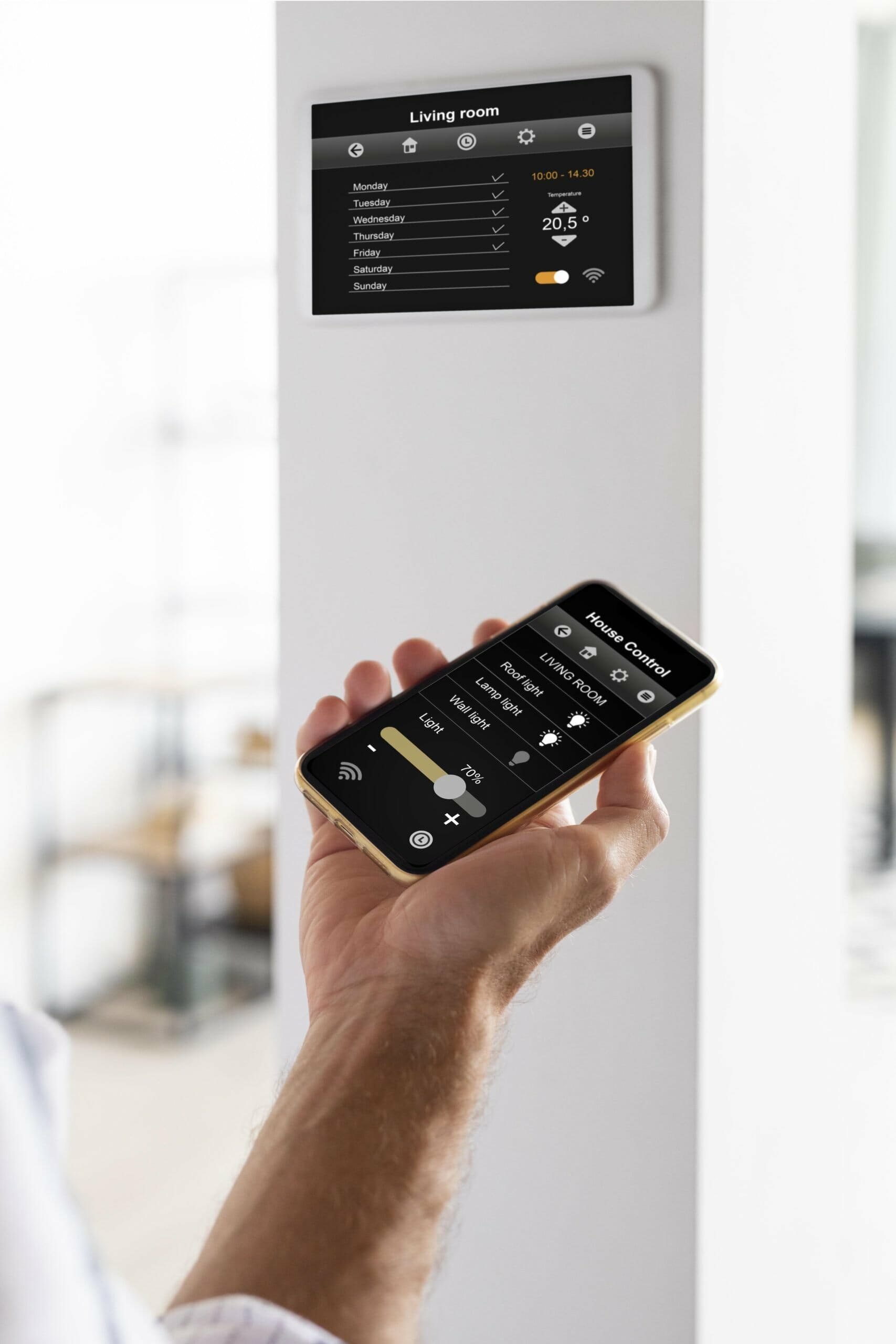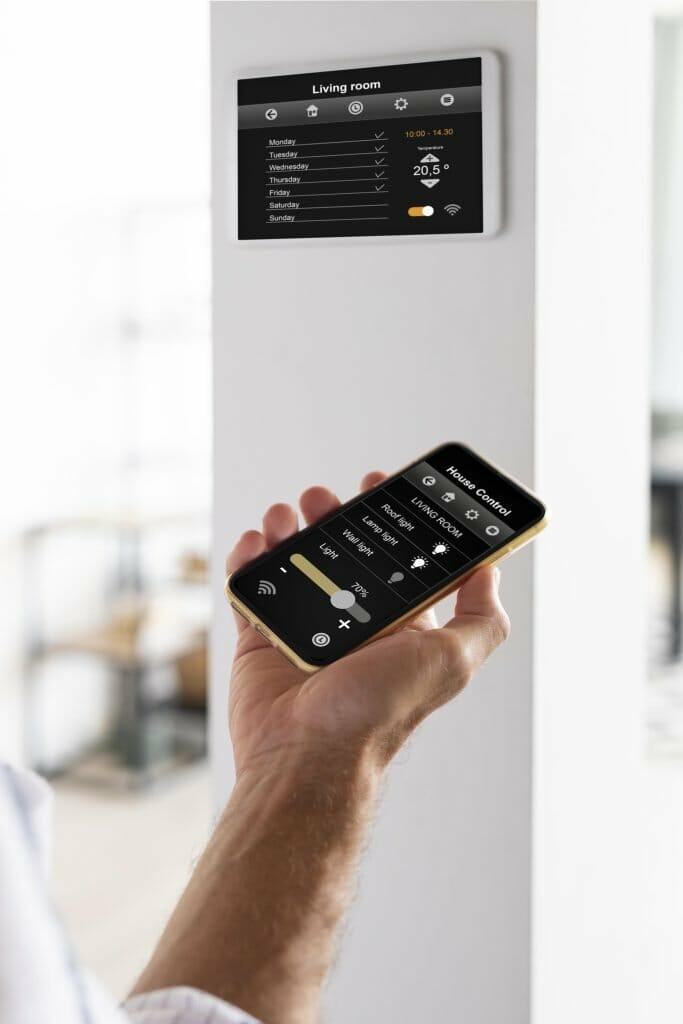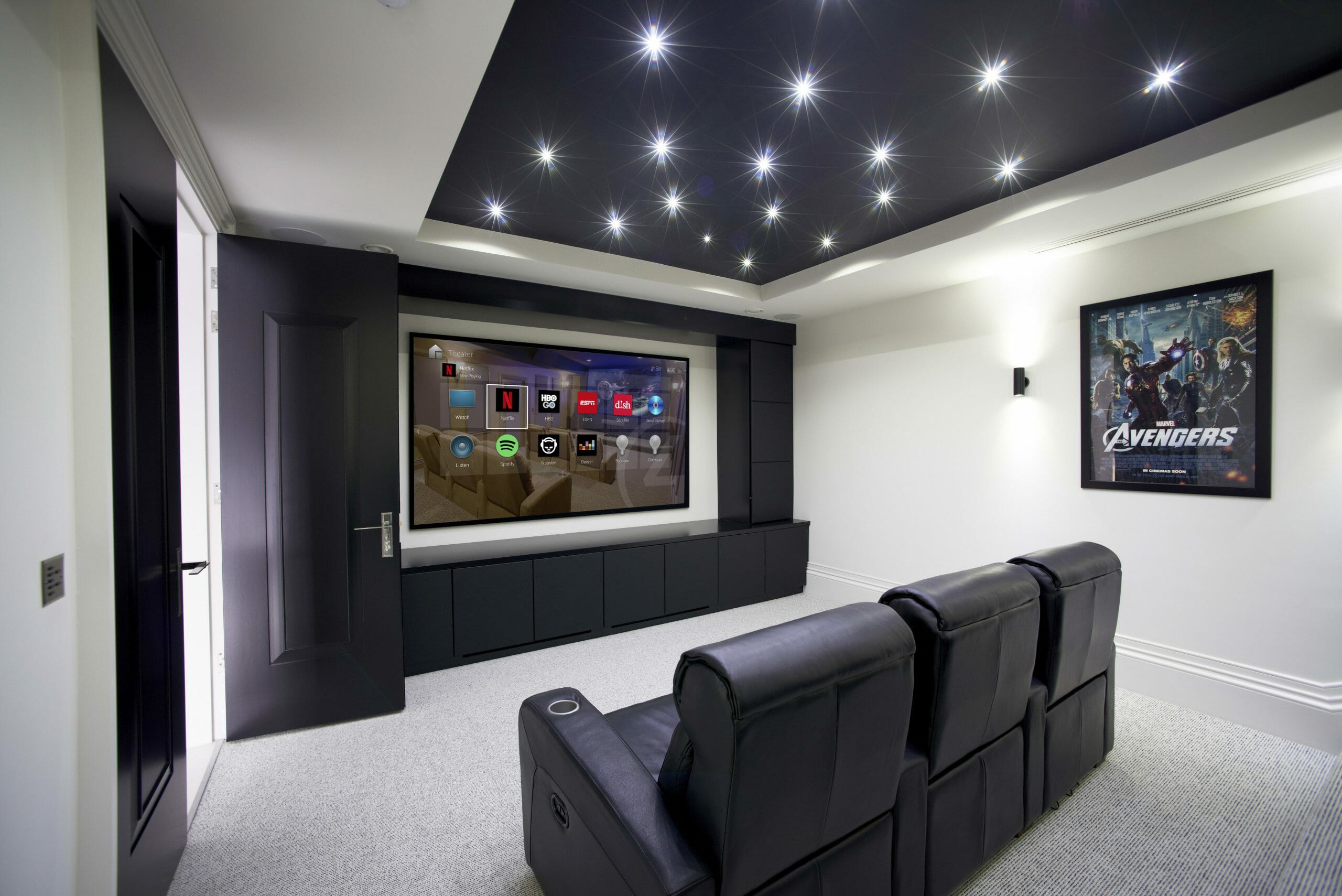Are you interested in making your home smarter, but unsure how to integrate automation systems with existing structures? It’s a pressing issue for many, as smart home integration technology has become increasingly popular over the last few years. Our blog post will guide you through the process, from understanding what smart home automation is, its benefits and components, to steps on planning and installation. Ready for a tech-savvy transformation at your place? Let’s get started!
Understanding Smart Home Automation Systems
Smart home automation systems utilize advanced technology to control and monitor various aspects of a home, offering increased efficiency and convenience for homeowners.

What is Smart Home Automation?
Smart home automation employs internet-connected devices for the remote management of appliances and systems in your house. This advanced setup presents a breakthrough in domestic technology, allowing automatic control of networked appliances through any device connected to the internet.
The system navigates daily tasks and controls various devices remotely, providing homeowners with unparalleled convenience and efficiency. From lighting to heating systems and even security alarms, nearly every household appliance can be linked to this dynamic framework.
Through smart home automation, homes gain an extra layer of security while delivering enhanced comfort and energy efficiency for a seamless living experience.
How do Smart Home Integration Systems Work?
Smart home integration systems lean heavily on the power of internet-connected devices. These cutting-edge solutions provide remote monitoring and management of appliances and systems, all from the convenience of a smartphone or computer. The magic unfolds once you link your home appliances to a central hub that controls all smart devices in your home.
Crucial to this process are Internet of Things (IoT) services and cloud computing technologies, which add intelligence to sensors and actuators in smart home integration systems. This union results in a system with high energy efficiency, offering comfort and security for homeowners. Furthermore, homeowners can readily access, view, control each part of their automated system using any internet-connected device; thus dramatically increasing their capacity to manage their homes effectively.
This integration is not only efficient but also quite flexible as it allows users to customize how various components work together based on personal needs or preferences. Whether it’s setting the thermostat at specific temperatures throughout the day or programming lights to switch off when everyone leaves, all these tasks can be seamlessly executed by an effective smart home automation system.
Benefits of Integrating Smart Home Automation with Existing Home Infrastructure
Integrating smart home automation with existing infrastructure offers increased efficiency, convenience, energy savings, and enhanced security and safety.
Increased Efficiency and Convenience
Smart home automation provides the ultimate form of convenience by placing total control over your devices right at your fingertips. The ability to manipulate all connected appliances and systems, such as lighting or heating, through a smartphone or tablet means you can always create the perfect environment in advance of arriving home.
This streamlined approach does away with unnecessary manual operations, boosting efficiency significantly. Occupancy detection capabilities also enhance this feature further. These sensors automatically adjust settings according to your presence and preferences, offering seamless operation that not only promotes comfort but saves energy as well.
Achieving an efficient home has never been easier with smart home automation systems integration!
Energy Saving Capabilities
Integrating smart home automation with existing home infrastructure can significantly enhance energy-saving capabilities. By connecting devices and systems, homeowners gain real-time monitoring and control over their energy usage.
With the help of wireless sensor technology and computational intelligence, smart homes optimize the operation of appliances for efficiency. This leads to reduced energy consumption, lower utility bills, and a more eco-friendly lifestyle.
By implementing remote device control and advanced scheduling features, homeowners can ensure that their devices operate only when needed, further maximizing energy savings.
Enhanced Security and Safety
Smart home integration systems offer enhanced security and safety for homeowners. By integrating these systems with existing home infrastructure, homeowners can enjoy a range of benefits that help protect their property and loved ones.
One key advantage is the ability to detect and respond to potential threats in real-time. With smart home automation, homeowners can have access to real-time monitoring and surveillance capabilities, allowing them to keep an eye on their homes from anywhere at any time.
This remote monitoring feature provides peace of mind and ensures that homeowners are always aware of what’s happening in their absence.
Furthermore, integration with existing security systems, such as the popular ADT home security system, is seamless with smart home automation. Homeowners can enhance their current security measures by incorporating advanced technology provided by automation systems.
Steps to Integrate Smart Home Automation with Existing Home Infrastructure

Assess your existing infrastructure, plan and design the automation system, select compatible devices and technologies, install and set up the system, and test for seamless integration.
Ready to transform your home into a smart haven? Read on!
Assessing the Existing Infrastructure
Smart home integrators begin the process by assessing the existing infrastructure of your home. This involves examining the control systems, power monitoring capabilities, communication infrastructure, and energy consumption patterns.
By understanding how your home is currently set up and identifying any areas that need improvement or modification, they can develop a customized plan to seamlessly integrate smart devices into your existing setup.
Proper assessment ensures that the new technology will be compatible with your current infrastructure and allows for a smooth transition to a smarter home environment.
Planning and Designing the Automation System
To integrate a smart home automation system with your existing infrastructure, careful planning and design are crucial. Start by assessing your current setup and identifying areas where automation can enhance efficiency and convenience.
Consider the devices you want to control remotely, such as lighting, heating, or security systems. Select compatible devices that work seamlessly with the chosen automation technology.
Installation and setup should be done strategically to ensure optimal functionality. Finally, testing and troubleshooting will help identify any issues before enjoying the benefits of an automated home system.
Selecting Compatible Devices and Technologies
When integrating smart home automation with existing home infrastructure, selecting compatible devices and technologies is a crucial step. Device compatibility ensures that the different components of your smart home system integration can work together seamlessly.
It’s important to consider whether the devices you choose will be able to communicate effectively with each other and integrate with your existing home infrastructure.
One key aspect to consider is the protocols used by the devices. Protocols provide the necessary infrastructure for communication between devices in a smart home system. By ensuring that all your devices use compatible protocols, you can avoid any issues with connectivity or interoperability.
Another factor to keep in mind is the compatibility of your chosen devices with voice services and other popular platforms such as Google Assistant or Amazon Alexa. This allows you to control your smart home using voice commands, adding an extra level of convenience and ease of use.
Installation and Setup
Smart home automation systems require proper installation and setup to ensure seamless integration with existing home infrastructure. This involves several significant steps, such as installing compatible devices, configuring wiring, and setting up software applications.
During the installation process, it is crucial to prioritize enhanced security measures by utilizing advanced cybersecurity protection. Additionally, building a smart home system involves developing customizable.
Testing and Troubleshooting
Testing and troubleshooting are crucial steps in the process of integrating smart home automation systems with existing home infrastructure. Through testing, any potential issues or compatibility problems can be identified and resolved before the system is fully implemented.
Troubleshooting allows for the identification and resolution of any concerns that may arise after installation. By thoroughly testing and troubleshooting, homeowners can ensure that their automation system functions efficiently and securely, providing them with the convenience, energy savings, and enhanced security they desire.
In addition to addressing limitations, testing and troubleshooting also help protect customer information by understanding and mitigating cybersecurity risks associated with smart home automation systems.
Choosing the Right Smart Home Automation System for your Home

Research available options, consult with professionals, and consider your budget and future expandability to ensure you find the perfect smart home integration system for your needs.
Researching Available Options
To choose the right smart home automation system for your home, it is important to research the available options. There are various systems to consider, such as SmartThings, Apple HomeKit, and Amazon Alexa.
Each of these options offers different features and compatibility with other devices. By conducting thorough research, you can find a system that seamlessly integrates with your existing home infrastructure and meets your specific needs.
Additionally, researching different options allows you to compare prices and consider future expandability. So take the time to explore the market before making a decision for a smarter and more connected home environment.
Consulting with Professionals
Smart home automation can be a complex process, which is why consulting with professionals is highly recommended. These experts, often known as smart home integration specialists or intelligent home system advisors, have the necessary expertise to seamlessly integrate smart technology into existing home infrastructure.
By working closely with manufacturers and understanding compatibility requirements, they ensure that the installation and integration process goes smoothly without disrupting your current setup.
In addition to their technical know-how, these professionals can provide valuable guidance in selecting the right devices and technologies for your needs while considering budget constraints and future expandability.
Considering Budget and Future Expandability
Choosing the right smart home automation system for your home involves considering both budget and future expandability. It’s important to find a system that is cost-effective and fits within your price range.
Look for options that are budget-friendly, allowing you to make a long-term investment without breaking the bank. Additionally, consider the scalability and flexibility of the system.
You’ll want one that is future-proof and can be easily upgraded or expanded as your needs change over time. By carefully considering these factors, you can decide a smart home integration systems that not only meets your current requirements but also has room to grow with you in the future.
Conclusion
In conclusion, integrating smart home automation systems with existing home infrastructure offers a range of benefits. By incorporating connected devices, central control systems, and communication protocols, homeowners can enjoy increased efficiency and convenience.
Additionally, the integration of smart home technology enhances energy savings capabilities and provides enhanced security and safety features for peace of mind. With proper planning and consideration of compatible technologies, homeowners can seamlessly integrate these systems into their existing homes.
FAQs
1. Can I integrate smart home automation systems with my existing home infrastructure?
Yes, you can integrate smart home automation systems with your existing home infrastructure by connecting compatible devices to a central hub or using wireless protocols such as Wi-Fi or Bluetooth.
2. Do I need to make any changes to my home’s wiring for smart home integration?
In most cases, no changes to the existing wiring are required for integrating smart home automation systems. Wireless technologies and plug-and-play devices make installation easier and more convenient.
3. What types of devices can be integrated into a smart home system?
A wide range of devices can be integrated into a smart home system, including lights, thermostats, security cameras, door locks, entertainment systems, and appliances. Compatibility may vary depending on the specific brand and model.
4. Are there any limitations or challenges in integrating smart home automation systems?
While integrating smart home automation systems is generally straightforward, some challenges may include compatibility issues between different brands or models of devices. It’s important to ensure that all components are compatible before purchasing and installing them.
